The History of Gamma-ray Astronomy
The History of Gamma-ray Astronomy
Long before experiments could detect gamma-rays emitted by cosmic sources, scientists had known that the Universe should be producing such high energy photons. Hard work by several brilliant scientists had shown us that a number of different processes which were occurring in the Universe would result in gamma-ray emission. These processes included cosmic ray interactions with interstellar gas, supernova explosions, and interactions of energetic electrons with magnetic fields. In the 1960s, we finally developed the ability to actually detect these emissions and we have been looking at them ever since!
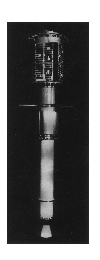 |
Gamma-rays coming from space are mostly absorbed by the Earth's
atmosphere. So gamma-ray
astronomy could not develop until it was
possible to get our detectors above all or most of the atmosphere,
using balloons or spacecraft. The first gamma-ray telescope carried
into orbit,
on the Explorer XI satellite in 1961, picked up fewer than
100 cosmic gamma-ray photons. These appeared to come from all
directions in the Universe, implying some sort of uniform
"gamma-ray background". Such a background would be expected
from the interaction of cosmic rays (very energetic charged particles
in space) with gas found between the
stars.
|
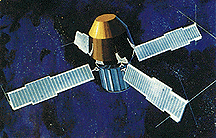
Additional gamma-ray experiments flew on the OGO, OSO, Vela, and Russian Cosmos series of satellites. However, the first satellite designed as a "dedicated" gamma-ray mission was the second Small Astronomy Satellite (SAS-2) in 1972. It lasted only seven months due to an electrical problem, but provided an exciting view into the high-energy Universe (sometimes called the 'violent' Universe, because the kinds of events in space that produce gamma-rays tend to be explosions, high-speed collisions, and such!). In 1975, the European Space Agency launched a similar satellite, COS-B, which operated until 1982. These two satellites, SAS-2 and COS-B, confirmed the earlier findings of the gamma-ray background, and also detected a number of point sources. However, the poor resolution of the instruments made it impossible to identify most of these point sources with individual stars or stellar systems.
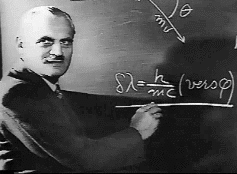 |
Show me a movie about Dr. Compton
|
The man seen in this image is Dr. Arthur Holly Compton. He won the Nobel Prize for Physics in 1927 for his work on the scattering of high-energy photons by electrons - which is something very basic to most gamma-ray detection techniques. The Compton Gamma-Ray Observatory was named in his honor after it went into orbit in April 1991. It continued to operate until June 2000, giving scientists the best look they have ever gotten of the gamma-ray universe.
So what are gamma-rays and what can they tell us about the cosmos? Gamma-rays are the most energetic form of electromagnetic radiation, with over 10,000 times more energy than visible light photons. If you could see gamma-rays, the night sky would look strange and unfamiliar. The familiar sights of constantly shining stars and galaxies would be replaced by something ever-changing. Your gamma-ray vision would peer into the hearts of solar flares, supernovae, neutron stars, black holes, and active galaxies. Gamma-ray astronomy presents unique opportunities to explore these exotic objects. By exploring the universe at these high energies, scientists can search for new physics, testing theories and performing experiments which are not possible in earth-bound laboratories.
 |
Show me a movie about gamma-ray astronomy!
|
Gamma-Ray Observing Platforms
Most gamma-rays are absorbed by the Earth's atmosphere. Thus, cosmic gamma-rays are typically observed from high-altitude balloons and satellites.
Balloons
Balloons are often the ideal vehicle for science payloads. At energies greater than about 30 keV, hard (more energetic) X-ray and gamma-ray astronomy can be done from balloons. At these high photon energies, being above 99.7 % of the Earth's atmosphere (which is where you are with a balloon float altitude of 40 km) is as good as being above 100 % of the atmosphere!Balloon-borne hard X-ray and gamma-ray imaging telescopes provided the first images of the sky in the energy range 20-1000 keV. They discovered black hole candidate sources in the galactic center region, first imaged the cobalt-decay gamma-rays from the spectacular supernova SN 1987A, and provided the first capability to localize (and thus study) high-energy sources for comparison with more detailed lower-energy X-ray observations.
In the past, balloon flights typically remained at float altitude from several hours to one or two days, at best. Nowadays, however, there are balloons called Long-Duration Balloons (or LDBs) which typically stay aloft for 3 weeks or more. They can carry a payload of over 2000 kg, with active experiment areas of up to 30 m2! Perhaps just as importantly in the modern era, balloon experiments are relatively inexpensive (when compared to satellite missions). Ballooning today is not the same as ballooning in the past!
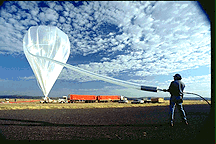
Filling the balloon for a flight of the GRIP payload
Satellites
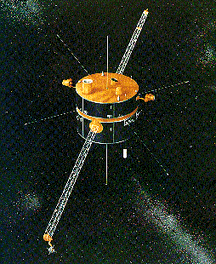
Satellites provide an excellent platform from which to observe cosmic gamma-rays. One reason is that the intensity, or flux, of cosmic gamma-rays arriving at the Earth is very low when compared to other sources of high-energy photons. Thus, staying in orbit observing for many months or years allows scientists to gather more and more cosmic gamma-rays. The more "real" gamma-rays they collect, the better their data analysis can be. Since 1961 when the first satellite went into orbit carrying a detector sensitive to energies greater than 50 MeV, many satellites have flown to observe cosmic gamma-rays. While the first satellite, Explorer-11 detected only 22 cosmic gamma-rays, 621 events attributable to cosmic gamma-rays were detected by the OSO-3 satellite in 1967. Since then, the sensitivity of the detectors has increased by factors of 1000! This has allowed scientists to make many fascinating discoveries in the high-energy universe. For example, they have mapped the diffuse gamma-ray background, found gamma-ray pulsars, and discovered the still-unexplained cosmic gamma-ray bursts! NASA's Wind satellite, pictured on the right, has 2 instruments which have been monitoring these bursts since 1994.
Targets of Gamma-ray Observations
Observing the Universe in gamma-rays allows us to examine things which are happening that cannot be seen with ordinary telescopes and, yet, which are very important in helping us to understand how matter and radiation interact with each other. This is especially true for understanding their interaction under extreme conditions, such as where temperatures are hundreds of millions of degrees, matter is very dense, or magnetic fields are very strong.Some specific targets include:
| Gamma-ray Bursts |
Black Holes and Neutron Stars | |
| Supernovae |
Pulsars | |
| Unidentified Sources |
Diffuse Emission | |
|
Active Galaxies: Seyferts and Quasars | ||

